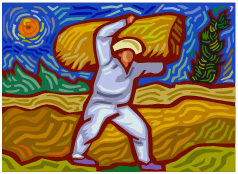 The Homestead Act of 1862 was one of the largest giveaways of land in U.S. history. It would encourage millions of Americans to pack up and move West to the Great Plains and beyond.
The Homestead Act of 1862 was one of the largest giveaways of land in U.S. history. It would encourage millions of Americans to pack up and move West to the Great Plains and beyond. The Homestead Act of 1862 was one of the largest giveaways of land in U.S. history. It would encourage millions of Americans to pack up and move West to the Great Plains and beyond.
The Homestead Act of 1862 was one of the largest giveaways of land in U.S. history. It would encourage millions of Americans to pack up and move West to the Great Plains and beyond.
The Homestead Act offered settlers 160 acres of land basically for free (they had to pay $18 in filing fees with the government to claim the land) in exchange for three conditions:
The Homestead Act would be in effect until 1986. The U.S. government would ultimately give away 270 million acres of land, or roughly 8% of the United States.
Reflection: If the government offered you 160 acres of free land, but you had to live there for five years and become a farmer would you move?
Economists have a saying, "there is no such thing as a free lunch," which means that everything has a cost. For people who wanted free land, it turned out that "free" proved a lot more costly than at first glance.
 Today, with modern farming techniques, the Great Plains serve as the world's bread basket with vast fields of corn and wheat. In the 19th century, they actually were incredibly difficult to farm. It was very hot on the Plains and it rarely rained. The rich soil was beneath layers of sod, or sun-baked grass, that was back-breaking to dig up. In fact, the sod was so tough people could build their homes out of it. When the wind kicked up in the summertime it blew dust everywhere.
Today, with modern farming techniques, the Great Plains serve as the world's bread basket with vast fields of corn and wheat. In the 19th century, they actually were incredibly difficult to farm. It was very hot on the Plains and it rarely rained. The rich soil was beneath layers of sod, or sun-baked grass, that was back-breaking to dig up. In fact, the sod was so tough people could build their homes out of it. When the wind kicked up in the summertime it blew dust everywhere.
Finally, on these 160-acre homesteads in unsettled territory, life grew very lonely because there was nobody around them.
Examine the following photographs of homesteaders. Using the photographs and the information in the preceding paragraphs, describe what life might be like for them.
Finally, on these 160-acre homesteads, life could get very lonely. Neighbors were often miles apart from each other.
![]() Click on each picture to enlarge them.
Click on each picture to enlarge them.
Life as a homesteader proved so difficult that of the two million Americans who tried to get land, only about 800,000, or 40%, of them lasted the five years and were able to “prove up” and earn the final deed to their land.